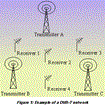Economical Simulation Software Aids DVB-T Network Management: Part I

Exploiting capabilities of Terrestrial Digital Video Broadcasting (DVB-T), a new software tool allows users to configure and manage the network ensuring a good level of service at low cost.
By: Antonio Sassano, Computer and Systems Science Department—University of Rome "La Sapienza" and Fabrizio Rossi and Stefano Smriglio, Pure and Applied Mathematics Department—University of L'Aquila
Advantages of a DVB-T system
The terrestrial digital video broadcasting (DVB-T) system is one of three standards for terrestrial digital television, the others being the US-based ATSC and Japan's integrated services digital broadcasting (ISDB). The standard is based on orthogonal frequency division multiplexing (OFDM), which combines echoes arriving from different transmitters within the same frequency block to obtain a useful signal. The technique leads to a better use of the most important and scarce resource for wireless networks: the number of frequencies needed to ensure an acceptable quality of service. A DVB-T system transmits a bouquet of programs—usually from one to four, depending on the transmission bit-rate—over a single channel.
A number of broadcasters are currently testing methods to guarantee the service's quality by a single frequency network (SFN), i.e. a network working with only one frequency, or by a multi-frequency network (MFN) with the minimum number of frequencies. DVB-T is most prominent in European countries as well as Australia and New Zealand. Singapore also recently selected DVB-T as the terrestrial digital broadcast standard of choice.
Until now, researchers have focused their attention mainly on mathematical models for field propagation and strength evaluation. These models are the basis of the simulation software used to evaluate the performances of the network. However, the practical realization of a DVB-T network involves optimization solutions that should provide a high quality service over a wide territory while controlling implementation costs.
Description of DVB-T
DVB-T allows broadcasters to provide digital services in a given area with a minimum standard of quality. Since service quality cannot be monitored in every area, a "natural" discretization of the service area is obtained by using a digital terrain database with rasterized altitude information. These fundamental area elements are called testpoints which have the attributes of size, location (latitude and longitude), height, and number of inhabitants.
In DVB-T, unlike in analog television systems, a small reduction in the signal can cause service failure. For this reason, the size of a testpoint ranges from 0.0625 to 4 km2, resulting in a large number of testpoints.
The following parameters determine transmitter configuration: site location (latitude and longitude), antenna height, physical parameters, frequency, polarization (horizontal/vertical), antenna diagram, power of emission, and temporal offset (radio-electrical parameters).
The field amplitude in a testpoint j, due to transmitter I, can be expressed as a sum of a constant factor (depending on physical and radio-electrical parameters) and as a function of emission power.
Analogously, the transmitter signal's arrival time at the testpoint j is the sum of the delay due to the distance between the transmitter and the receiver plus the temporal offset introduced by the broadcaster.
Receiving techniques
DVB-T systems involve a special receiving technique in which the channel estimation process in the receiver is based on a frequency domain interpolation filter. The pass band of this filter, called the detection window, is a rectangle whose width is called the guard interval.
Given a set of signals reaching testpoint j, the signals arriving in the guard interval are useful for the receiver while signals arriving outside the guard interval cause interference. The coverage assessment in testpoint j can be estimated using a probability function that takes into account the total signal usage power and the total power of interfering signals. The result is equal to the sum of the powers of the useful signals minus the sum of the powers of the interfering signals over a correction factor depending on the variance of the signals.
Consider, for example, a network where antennas A, B, and C radiate signals on testpoints one, two, three, and four (see Figure 1). Suppose that the temporal offset assigned is zero for all transmitters. In this case, receiver two captures the signals from all of the transmitters during the guard interval, since the receiver tower is the same distance from all the transmitters. In contrast, receivers one, three, and four, only receive the signals from two of the transmitters during the guard interval (i.e., A-B for receiver two, A-C for receiver three and B-C for receiver four), while the remaining signal generates interference. This is because the corresponding transmitter is further from the testpoint in relation to the other two transmitters.
In part II, we will look at how we integrated the network through an algorithmic framework to optimize the DVB-T network.
About the authors:
Antonio Sassano is a full professor of Operations Research, Computer and Systems Science Department—University of Rome "La Sapienza." Phone: +39 648 99221; Fax: +39 648 99218; E-mail: sassano@dis.uniromal.it
Fabrizio Rossi is a research assistant, Pure and Applied Mathematics, University of L'Aquila, L'Aquila, Italy. Phone: +38 862 433139; Fax: +39 862 433180; E-mail: rossi@univaq.it
Stefano Smriglio is a research assistant, Pure and Applied Mathematics, University of L'Aquila, L'Aquila, Italy. Phone: +39 862 433139; Fax: +39 862-433180; E-mail: smriglio@univaq.it.
